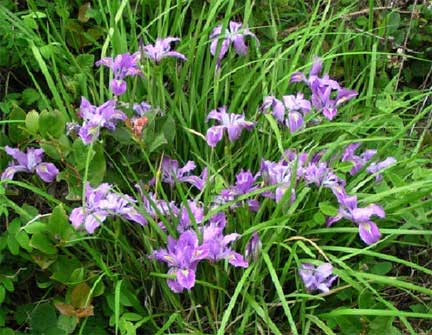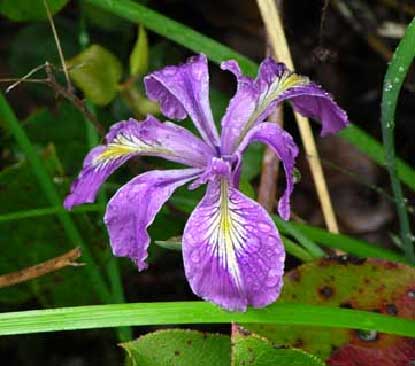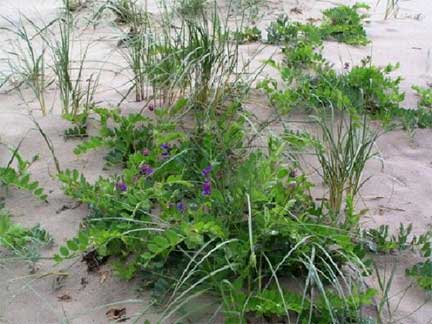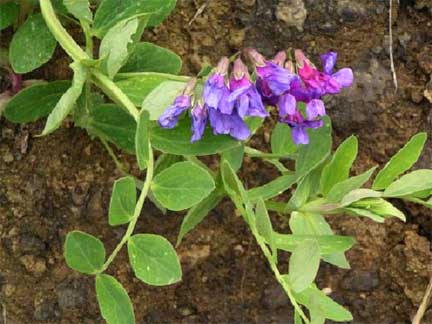|
 |
 |
|
A Guide to Wild Flowers Between the Capes
|
 |
 |
|
Blueish Flowers
|
 |
 |
|
Aster chilensis
California aster
Southern British Columbia to California
Family Asteraceae
Native
Asters can be difficult group to identify, not only to species, but sometimes they are even confused with daisies (genus Erigeron), and one may have to examine the arrangement of the involucral bracts to tell the difference. The perennial California aster (Aster chilensis) is a prominent in our area. It has bright yellow disk flowers surrounded by beautiful purple to bluish ray flowers. Its leaves are oblanceolate to obovate, usually without hairs. It spreads by rhizomes (underground stems), likes moist soil, and is common on coastal grasslands and marshes. Aster is from Greek meaning “like a star”. The specific name chilensis means “from Chile”, but it is native to California and the Pacific Northwest.
|
|
|
 |
 |
|
Iris tenax var. tenax
Oregon iris, Oregon flag, tough-leaved iris
Washington and Oregon
Family Iridaceae
Native
This beautiful native iris blooms locally in May and June. It is a perennial monocot with bright purple petals and sepals, strap-shaped leaves that are less than one-fourth inch wide, mostly basal but with two or three on the flower stem. Sepals are wider than the petals and are veined with yellow and white. The Oregon iris spreads by rhizomes. It is common along our coast, inhabiting road sides, trails, and fields.
|
 |
 |
|
 |
 |
 |
 |
 |
 |
|
 |
|
 |
|
|
|
Lathyrus japonicus var. maritimus
Beach pea
Alaska to California, Northeastern States and Provinces
Family Fabaceae
Native
Wending their way along the beach sand and cobbles, and climbing over driftwood one can find the angular stems and compound leaves of the beach pea, a legume, with its clusters of pink to blue flowers. The leaflets are pinnately arranged, usually 6 to 12. The ends of the leaves may extend into curly tendrils. Typical of legumes, the colorful flowers are irregular, that is, the petals are not all alike and the corolla is bilaterally symmetrical instead of round. They bloom in the spring and early to mid summer and then develop inedible, hairy pods. The seed contains a toxic amino acid that, when eaten in quantity, can cause a serious nervous condition called ‘lathyrism’. This is truly a beach plant, and is found only near the shore.
|
|
|
 |
|
 |
|
 |
 |
|
Lathyrus littoralis
Silky beach pea, gray beach pea
British Columbia to California
Family Fabaceae
Native
This prostrate perennial is strictly coastal and can be found among the dunes on Netarts Spit. Its bright flowers, usually three to five in the inflorescence, have a violet banner and white wings. Its leaflets have an oblanceolate shape, which means that they are shaped like a long pointed spatula and are attached to the rachis at their tapered end. They are covered with silvery hair, giving the plant a gray-green appearance. Look for them along the backshores of the beach at the end of the spit.
|
 |
 |
|
Lupinus littoralis
Seashore lupine
British Columbia to California
Family Fabaceae
Native
Another member of the pea family that you will find growing along the beach is the sprawling seashore lupine, a native prostrate perennial that is never far from shore. The pink to blue irregular flowers are arranged in a spike at the end of a stem. The leaves are palmately compound with five to eight pubescent leaflets. The small hairs on the leaflets can cause dew or rainwater to bead up into rows of liquid jewels, as shown in the lower picture. (The insect in this picture is Largus cinctus, the bordered plant bug, a member of the red bug family.) Seashore lupine has a long, thick, fibrous, but edible tap root that was called “Chinook licorice” by early settlers because it was eaten by native peoples. It is reported to have a sweet flavor, but should be eaten cooked. Cooking denatures toxic alkaloids contained in the root.
|
 |
 |
|
Myosotis arvensis
Common or field forget-me-not
British Columbia to Oregon
Family Boraginaceae
Non-native
This small blue flower is another European import. It is sometimes called scorpion grass because the curl of the inflorescence (a cyme) looks like the curl of a scorpion’s tail. There are numerous legends floating around the internet about the origin of the name “forget-me-not”. One is that the flower was given by knights to their lovers as a sign of remembrance, that is, “don’t forget me when I go off to battle”. I’ll leave it to the reader to ferret out other tales. The common forget-me-not is an annual or biennial having five-part blue flowers with yellow centers. Each flower forms a tube that flares into five lobes. The calyx is hairy, and the end of each hair is hooked (see picture). Leaves are alternate, broadly lanceolate, and somewhat hairy.
|
 |
 |
|
Prunella vulgaris
Self heal, heal all
Alaska to California, most of North America
Family Lamiaceae
Native
This widespread perennial member of the mint family has been a traditional herbal medication for hundreds of years, both in Eurasia using P. vulgaris subsp. vulgaris, and by Native Americans using P. vulgaris subsp. lanceolata. Both subspecies occur in Oregon, but the one we have in our area is the native variety. It has irregular purple (sometimes white) flowers clustered in spike atop an erect stem. Petals consist of a fused tube with upper and lower lobes, the upper forming a hood and the lower with a fringe on its edge. Sepals are united. Leaves are opposite, about three times as long as wide (the European variety has shorter leaves), often with a purple edge. It may bloom most of the spring and summer into the fall.
As its common name suggests, it is purported to have multiple healing properties and is prevalent in today’s herbal medicine market. It is used to treat internal and external wounds, high blood pressure, herpes, and allergic reactions. It is said to be an antioxidant, stimulate the immune system, inhibit the replication of viruses, and reduce inflammation.
|
|
|
|
|
|

